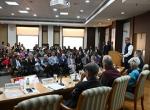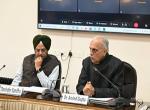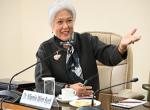The Vivekananda International Foundation (VIF) organised a Round Table Discussion on ‘India-China Relations: Global, Regional and Bilateral Context’, including the economic issues. The speakers at the Round Table were:-
- Amb. Ashok Kantha, former Ambassador to China,
- Lt Gen S L Narasimhan, Member NSAB,
- Vice Adm Anil Chopra, Member NSAB,
- Amb. Kanwal Sibal, former Foreign Secretary.
The list of issues were given to the speakers to deliberate and focus on during the presentation. Strategic and diplomatic ties with China having multiple consequences for our security, economy, environment and relations with our neighbours and the world, the following issues/questions were focused upon:-
- Do the recent changes in China’s Constitution and leadership succession, especially the indefinite extension of terms for Communist Party General Secretary and PRC President Xi Jinping (as well as that of the Vice President), cause for concern?
- How do we explain the reasons for the changes and the likely Chinese external strategy in Xi’s ‘New Era’?
- Do the recent political changes in China create a distinctly new political situation in India-China relations that requires a changed policy response from Delhi?
- What should be our response to Xi’s determination to pursue the Belt and Road Initiative with even greater vigour in his second term since it is one of the pillars of China’s new global and Asian strategy?
- How can we make our own aid, trade and investments more effective, expansive and strategically meaningful in the immediate and extended neighbourhood to neutralise China’s rising economic influence and capture of markets?
- Related to the above, is the question of how India can meet the growing techno-economic challenges posed by China and the persistent large trade deficit with it?
- What should be India’s response to Chinese military build-up and its impact on security?
Director VIF, Dr. Arvind Gupta, delivered the opening remarks and laid out the agenda that there is a need for a regular discussion on China and such events should be organized at least twice a month. The major areas which were discussed during the Round Table were:
Change in Chinese Constitution and its Implications
The recent changes introduced to the Chinese Constitution during the National People’s Congress (NPC) are a clear indication that there is a push in China to a one-man authoritarian phase with the belief that the supreme leader will deliver. China has moved away from the Deng Xiaoping era and legacy of ‘collective leadership’ and this shift will have some serious ramifications. With time it is becoming clear that China is not interested in multi-polarity and its great power ambitions are becoming increasingly obvious. There is also a push towards centralization of power in China. There is also an urgent need to have a correct and proper assessment of what is happening in China and adopt subtle diplomacy.
This change is of some concern for India as there is no alternate power center to engage with. It’s clear that Xi needs more time to achieve what he set out to do. However, as Xi amasses more power, it will help India to formulate strategy to deal with Xi. India needs to develop a long term strategy to deal with China and the growing Chinese nationalism. In future, Beijing will be focused on South China Sea, East China Sea, the United States, SCO and Taiwan and it will also get more involved in the Af-Pak region. There is a need to devise an offensive strategy and move away from thinking defensive.
China’s Military Restructuring
The current process of restructuring the military and reforms will go on till 2020 and the People’s Liberation Army (PLA) will see some stabilization after that. Till date the PLA may not be that effective. However, there will be an increase in the number of Chinese bases globally and there will also be a considerable strengthening of joint capabilities of the PLA. The clear vision behind the massive restructuring of the PLA is to have the capability to dominate Asia.
China is extending its reach and capacity as a maritime power and it has completely changed its maritime strategy. The recent induction of the Chinese Aircraft Carrier will have very deep psychological impact in the region as well as globally.
India needs to focus on building its capacities as it is undesirable to have a conflict with China. India should be ready to exploit the Chinese vulnerabilities in the Indian Ocean Region (IOR) and further develop and modernize its air force capabilities. The discussion also focused on Indian defence spending and the need to increase it and build matching capabilities with regard to Beijing. The idea of assertive deniability also needs to be explored, especially in the IOR. India’s geography is its biggest asset.
Chinese Economy
China’s economic clout is strong as it is the major trading partner of a large number of countries in Asia and most of these countries do not share security concerns of India. China has also been projecting itself as a successful and alternate model of economic growth.
There could be renewed focus on the private sector in China. The role of the Party in the private sector is likely to increase and there will also be a push to pitch yuan as an alternative to dollar. However, the dependence on external trade is a major weakness of China.
India needs to look for ways to better cooperate with China economically and also to restructure its trade relations.
India’s Response to the Belt and Road Initiative (BRI)
The BRI is a top-down concept. The underlying competition between China and India will remain and there is a need to assert the idea that the BRI is not in India’s interest. India should look for ways assert an alternative to the BRI by floating its own economic cooperation plans in Asia and Africa. Even though Japan appears to be leaning towards joining the BRI, it has set a number of pre-conditions while Australia appears to be getting disillusioned with the whole initiative.
QUAD
One of the major problems with QUAD is that it gives an impression that India may be compromising on its strategic autonomy and looking for partnerships. It was argued that India should be ready to cooperate with the United States, Japan and Australia and should not give undue weightage to the domestic politics.
Growing Chinese Influence in South Asia
The aggressive overtures of China in South Asia calls for a very sophisticated and balanced mix of cooperation and competition and India will have to look for ways to manage similar areas of interest and influence. There is a need to revamp Indian aid and make it more attractive and also undertake effective implementation of projects agreed upon. The poor response time and backlogs in deliveries requires an urgent rethink and correction.
New Delhi should work with the Maldives, Bangladesh and Nepal and try and convince them that the Chinese can in the long run undermine their sovereignty.
Role of New Technologies
There are clear indications that China will move towards using newer technologies as there is an added push for technology driven growth. China is systematically moving away from conventional deterrence to high end technological deterrence. In order to achieve these Chinese investments in cyber and space spheres is growing.
Role of Indian Media in Perception Management
The Indian media has the tendency to exaggerate incidents and events vis-à-vis China. There is an urgent need to reign in the media and have some proper filtering and reporting. The 1962 War has given rise to an inferiority complex within the Indian media. The demoralizing stance adopted by the India media works in China’s favour. The panelists asserted that there is a need for a change in approach in the Indian media.
The direction of the general discussion was to find an answer to whether India and China can have a balanced relationship and the steps India needs to adopt in order to achieve this. Another question which needed immediate attention is the ways by which India can develop its capabilities to deal with China.








Post new comment